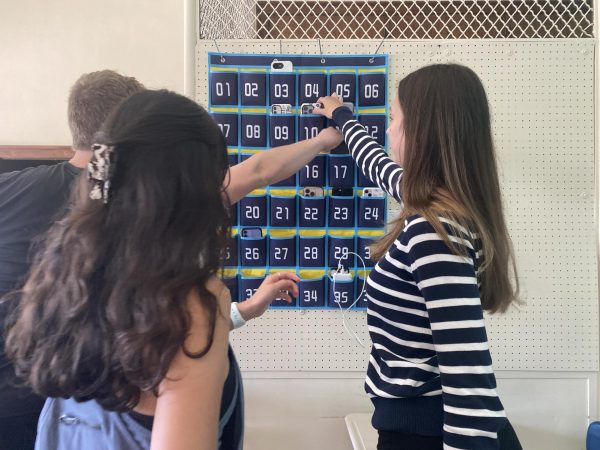The ways of grade weights

History Teacher Mrs. Smith grading her students’ papers.
Sweat trickles down students’ hands as they’re filled with anxiety, frantically checking their grade on student portal after finals.
Yikes. Grades.
Students have all been there, attributing that one poor grade to that one category average. Ever since GradeBook was integrated into Chicago Public Schools (CPS), teachers have been trying to find a balance with incorporating different factors into their student’s grades.
When students hear “GradeBook” they often correlate percentages to their teachers’ grading systems. Whether it be strict zero policies or how they weight grades in different categories, teachers ultimately decide how they grade based on what they view an appropriate structure for their class.
Due to some parental and student concerns, a uniform system where all departments have a consistent grade policy “would be ideal,” accord- ing to Assistant Principal Mrs. Hanly.
When asked about possible uniformity, Dru Pozek, Div. 051, said, “Teachers of the same department such as English or Math should come together and be able to decide collectively how they grade things because when teachers do it by themselves, sometimes it’s not fair to the students.”
A new policy change could result if departments agree to have uniform weights, according to Hanly.
“I’m not saying that that’s not a conversation that people should be having, but I think in general, teachers across the board like the autonomy in their classes to do what they want,” Hanly said.
Future changes would have to be reviewed and researched to prove any results.
Teachers have their own novel ways of looking at grades. English teacher Mr. Fine said that he doesn’t really focus on the number when giving a final grade, where an “‘A’ is outstanding work, a ‘B’ is very good work, and a ‘C’ is average.”
There have been numerous changes over the years in how teachers establish final grades.
“In my opinion, teachers are easier on students today than they certainly were 20 years ago when I started teaching,” Hanly said. “I don’t know if students are more likely to be advocates for themselves or if their parents are more vocal, but I never had a student question a grade or a parent question anything,” she said.
From the murmur of Lane’s hallways, anyone could hear the questions students ask about this grade and that grade.
“What is the point of grades? What is the point of transferring those numbers?” said Computer Science teacher Mr. Hayes. “We’re rounding these numbers to a letter and that really goes back to how we did it before,” he said.
From college choices to choosing class courses, a grade point average gives insight of where the student stands with others.
“One of the things we should be communicating with grading both to the student and future academic institutions is the likelihood of that student’s continued academic success and one major factor in that is not how they deal with tests, but their development of academic skills and discipline,” Hayes said.
While GradeBook offers students the chance to see where they stand in mastering skills, a common complaint is that one low grade or a zero could completely throw them off.
It depends on the teacher on whether they think a no-zero policy is effective. “Credit shouldn’t be given to students who don’t turn in any work or make any effort to make it up,” Hanly said.
Instead of adhering to a category weight arrangement, Social Science teacher Ms. Paras uses a point system.
“Honestly, I use it because it makes more sense to me,” she said. “I guess it would be more fair because some people aren’t the best test-takers so if you make your test worth a really high percentage and they continue to not do well on tests, it’ll pull down their grade,” she said.
Ms. Hanson, Drama teacher, said that her total weight logic compares to the customary category weight system. Assessments and big projects are out of more points than certain homework assignments.
“Quite frankly I think it’s the same. I think it’s semantic,” she said.
Department Chair of Biology, Ms. Whittaker, is torn between the idea of complying to uniform weights across her department.
“In theory, it’s a really good idea. However, what concerns me is that every teacher teaches differently,” she said.
Taylor Fitzgerald, Div. 761, began getting involved with the college process, sending all her college applications and transcripts to the schools of her choice. Though the process itself can be excruciating, the final grades and scores are what count.
“I don’t feel like that one grade should define somebody,” Fitzgerald said.
With time and research, it’s possible that GradeBook could adhere to more uniform weights across similar departments. It’s up to CPS to promote or discourage further teacher autonomy with grading. Just as Fitzgerald said, “It should still be fair.”
Your donations directly fund the Lane Tech student journalism program—covering essential costs like website hosting and technology not supported by our school or district. Your generosity empowers our student reporters to investigate, write, and publish impactful stories that matter to our school community.
This website is more than a publishing platform—it's an archive, a research tool, and a source of truth. Every dollar helps us preserve and grow this resource so future students can learn from and build on the work being done today.
Thank you for supporting the next generation of journalists at Lane Tech College Prep!

Dominika has been involved with The Warrior since her junior year. She participates in many extracurriculars at Lane; her activities range from Flag Corps...



